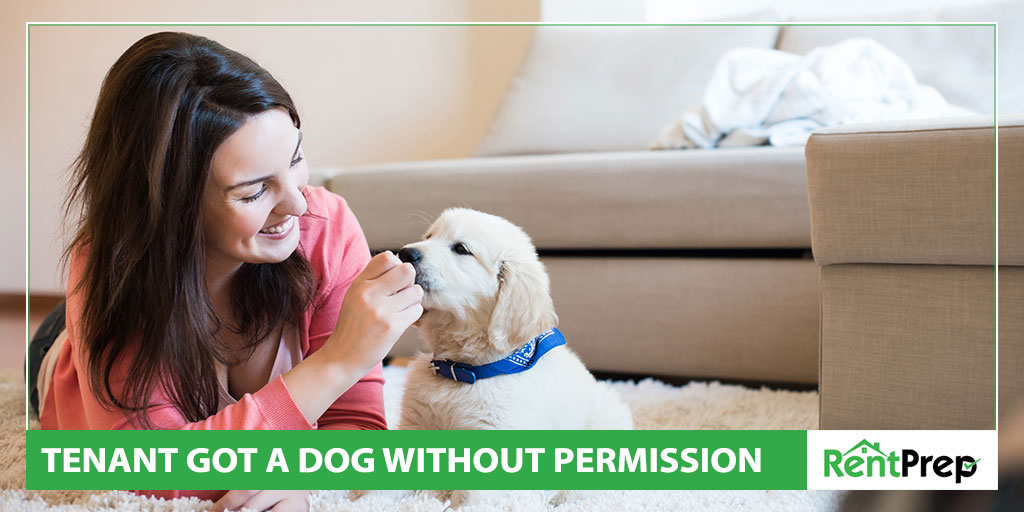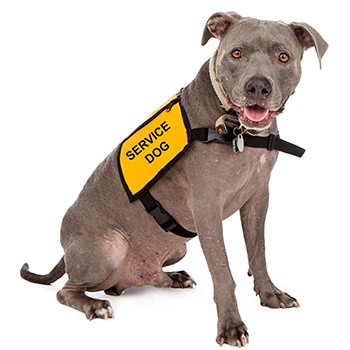
Dogs may be man’s best friend, but they aren’t always a landlord’s best friend!
One of the worst things you can imagine has happened. Your tenant got a dog without permission. While you love dogs, this is not allowed under the current rental contract. The entire situation is awkward, and you aren’t sure what to do next.
How do you handle things when a tenant has a dog without permission?
Regardless of your feelings about pets in general, you must act decisively to ensure your property and income are not put at risk by your tenant’s pet. Though it might seem dramatic, the effects of having a dog or pet in a rental property without following the proper channels can be incredibly problematic.
Pets can cause damages, increase liability, and lead to evictions. What can you do to prevent this situation from spiraling out of control? Here is how you can handle your reaction to this discovery.
A Table Of Contents On Tenants Owning Pets Without Permission
- What To Do When Tenants Have Pets Without Permission
- Pros and Cons of Allowing Pets
- What About Service Animals?
- Keep Pet Policies Clearly In The Lease
- FAQs: Tenant Got A Dog Without Permission
What To Do When Tenants Have Pets Without Permission
 What do you do when a tenant has a dog without permission? Dealing with this problem for the first time as a landlord is sure to be overwhelming. As with most rental issues, however, it is important that you work through things with diligence and order.
What do you do when a tenant has a dog without permission? Dealing with this problem for the first time as a landlord is sure to be overwhelming. As with most rental issues, however, it is important that you work through things with diligence and order.
Step 1: Lease Violation Notice
Your lease agreement likely includes a no pets policy that does not allow pets at the property or there is a requirement for the pet to be registered with you. If your tenant has a pet on the property without your permission, this means the tenant has committed a lease violation, and you should prepare to send them a notice.
The notice should state:
- What part of the lease has been violated
- What the tenant needs to do the fix the situation (i.e., remove the pet or register it depending on your lease terms)
- How long the tenant has to remedy the situation (usually up to one week)
While you could talk to the tenant directly, it’s better to send out an official notice. Sending an official notice will give you formal documentation of the process.
Step 2: Assess Fines As Necessary
Some lease agreements include detailed pets clauses that permit either a one-time pet fee or a daily charge for each day the illegal pet stays at the property. If your lease agreement has such a clause, you can send out a bill for these fees and a reminder that the fees will be applied until the situation is remedied.
If you do not have these fines outlined in your lease agreement, you cannot add them now. You should only charge fines if they are in the original lease.
Another situation that might lead to fines being charged is if the tenant decides to move out in order to keep their pet. In this case, they would be facing penalties for breaking the lease, and those should be charged accordingly.
Step 3: Modify The Lease, If Applicable
Are you willing to allow the tenant to keep their pet? If so, you will want to get together with the tenant ASAP to sign a lease addendum. This lease addendum should cover the pet fees that will be charged as well as how many pets will be allowed at the property.
Step 4: Eviction, If Applicable
If you are unhappy with the tenant for sneaking a pet in when your lease agreement clearly forbids pets, you may have a case for eviction. Begin the eviction process as soon as possible to handle this situation with the help of an eviction.
Pros And Cons Of Allowing Pets
Pros
- Larger potential renter pool when you are pet-friendly
- Pet owners are often responsible
- Longer tenancy periods
- People will not try to sneak in pets
- Can charge higher rent if there aren’t many pet-friendly properties around
Cons
- Pets can cause damage
- Pets can be loud
- Pets can increase liability
- Pets can cause odors
What About Service Animals?
 In some cases, a tenant may get a service animal even though you have a no pets policy. Are tenants allowed to do this even if you haven’t given permission?
In some cases, a tenant may get a service animal even though you have a no pets policy. Are tenants allowed to do this even if you haven’t given permission?
Assistance animals must be allowed under the reasonable accommodations required by the Fair Housing Act. More specifically, emotional support animals, therapy animals, and service animals will likely be allowed regardless of your pet policy because these animals are not considered to be pets.
As such, pet fees and pet rules regarding the size of the pet cannot be applied to the service animals. While you are permitted to request verification that the animal is medically necessary, you cannot ask for specifics of the disability that requires the animal.
For more information about how to handle assistance animals, review the full HUD guidelines here.
Keep Pet Policies Clearly In The Lease
All landlords should make sure they have a pet agreement or pet policy clause in their lease. Even if a tenant expresses that they have no interest in having pets, you should have your policy included in every lease. You never know when a tenant will change their mind!
A pet policy should require the following:
- Whether or not pets are allowed
- All pets must be registered with management
- How many pets can be at the property
- Types of pets allowed
- Size of pets allowed
- What pet-related fees will be charged
All pets that do not follow your pet protocol should be considered unauthorized pets and handled accordingly.
FAQs: Tenant Got A Dog Without Permission
Should I Let My Tenant Have A Dog?
Landlords must each develop their own stance on whether or not to allow pets at their property. While allowing pets can lead to additional upkeep needs between tenancies, the pet deposit or other pet fees will cover this expense in full. What matters most is whether or not you are willing to add on that work.
Allowing tenants to have pets can encourage more applications, and permitting a current tenant to get a pet may extend their tenancy period. Unless there are serious concerns with having pets at your property, allowing pets can be a good move for landlords.
Why Do Landlords Not Want Pets?
Even though allowing pets may expand the pool of potential rents, there are some landlords who still do not want to rent to pet owners or allow any pets at their properties.
Pets can cause excessive wear and tear to the property, and that will lead to a higher need for repairs between tenants. Additionally, you will need to do extra inspections to ensure this type of damage isn’t occurring or getting out of control. Loud pets, like barking dogs, can also be frustrating for tenants living in multi-unit buildings.
There are many pros and cons to allowing pets at your properties; only you can make the final call.
Can A Landlord Change The Pet Policy?
It is not possible to change the pet policy in the middle of a tenancy period without agreement from both parties. If your pet policy allows dogs and your tenant has a dog, you cannot simply tell them to get rid of the dog.
Remember that a lease is a legally binding contract. Once both parties have signed the agreement, nothing can be altered without both parties signing an addendum or a new lease.
If you want to be able to change your mind about the pet policy in specific ways, make sure this ability is written into your original lease before it is signed by both parties. You must follow the lease agreement to the letter after it is signed.
Can Landlords Enforce No Pets Policies?
As long as your original lease agreement outlined your no pets policy in detail, you can enforce that policy. There are some cases where you might lose the right to do so. For example, if you know that a tenant has a pet for many months or years but do not act on that knowledge, you might lose your right to refuse the pet living at your rental property.
This decision, however, would be made on a case-by-case basis. To avoid this loss of your right to enforce your policy, make sure to add a no-waiver clause to your lease agreements. A no-waiver clause says you can enforce the policies of the lease at any time, regardless of whether or not they were previously enforced.
This is a good clause to include in all leases. While courts are not required to follow this no-waiver clause if they feel it is unjust, it will give you a stronger case if you should need to go to a hearing over the issue. In some cases, local laws will dictate how long you have to take action, and those rules will always take precedence.
Can I Charge Extra Rent For Pets?
Depending on your local and state laws, it is possible to charge pet-specific fees, deposits, or rent. Usually, landlords choose to charge one of these three things:
#1 Pet Deposit
This deposit is a refundable, up-front payment that is held by the landlord to cover any pet-related damages at the end of the tenancy. Like a security deposit, it will be returned within a specific amount of time if there are no damages.
There may be a limit on how much you may charge for a pet deposit, security deposit, or for both combined, so be sure to check that amount before collecting this deposit.
#2 Pet Fee
Some landlords choose to charge an upfront fee to allow pets. Pet fees are a non-refundable cost that can be used by the landlord for basic cleanup after a pet lives in the unit. Note that pet fees are not legal in all states, so make sure that this is permissible before you enforce one.
#3 Pet Rent
Finally, you could opt to have a specific amount added to the rent each month to cover the pet allowance. In most cases, this would be between $20 and $75 per month. This type of fee is most common at large, multi-unit buildings, but it can be found at any type of residential rental.
How Much Should A Landlord Charge For Pets?
The amount you charge for pets will depend on which method of pet fee collection you choose. The average amounts for each type of payment structure are as follows:
- Pet deposit: between $500 and $1,500, usually limited to one or two months’ rent for the total security deposit
- Pet fee: between $100 and $500, a one-time fee
- Pet rent: between $20 and $75, a monthly fee added to rent
As always, the amount you can charge may be limited by your local or state government. Be sure to review the applicable laws before you finalize your fee structure.
Prepare For The Future
When tenants have pets without permission, it can feel like there is no other choice but to kick them out and suffer a huge loss. It’s easy to panic and assume that the worst will happen, but make sure to take a step back and determine how to best handle the situation:
- Are you willing to allow pets? If so, work that out together.
- Are they willing to rehome their pets? If so, give them time.
- Are you unable to meet a compromise? If so, move forward with an eviction.
Eviction may result from tenants having pets without permission, but it is not always a guarantee.
To avoid this situation happening in the future, make sure that your lease is fitted with a complete pet policy. Whether you allow pets or not, it is essential that your pet policy is incredibly clear about how pets will be treated at the rental. This can be key to retaining order and control over your property when pets are involved.

